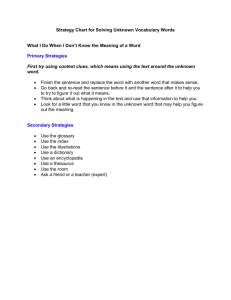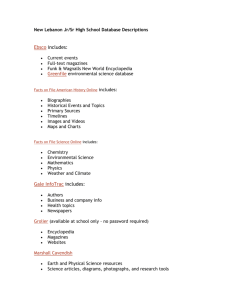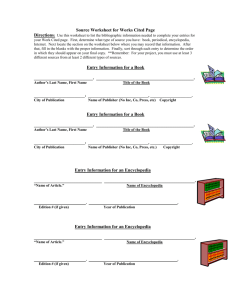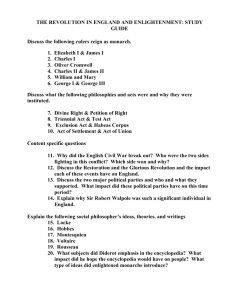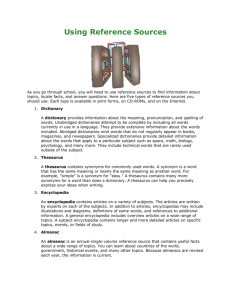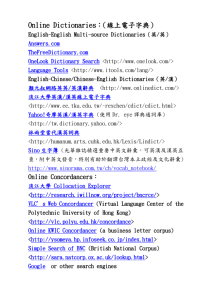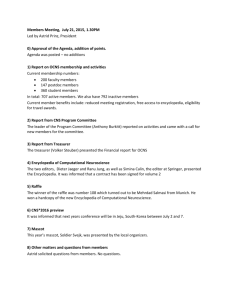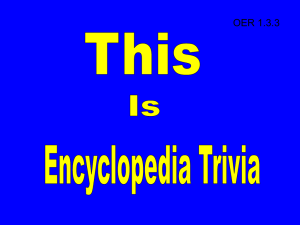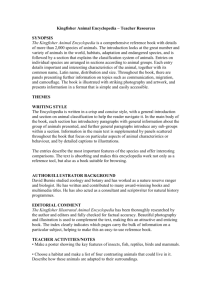Encyclopedias - Lisa Cole - School Library and Information
advertisement
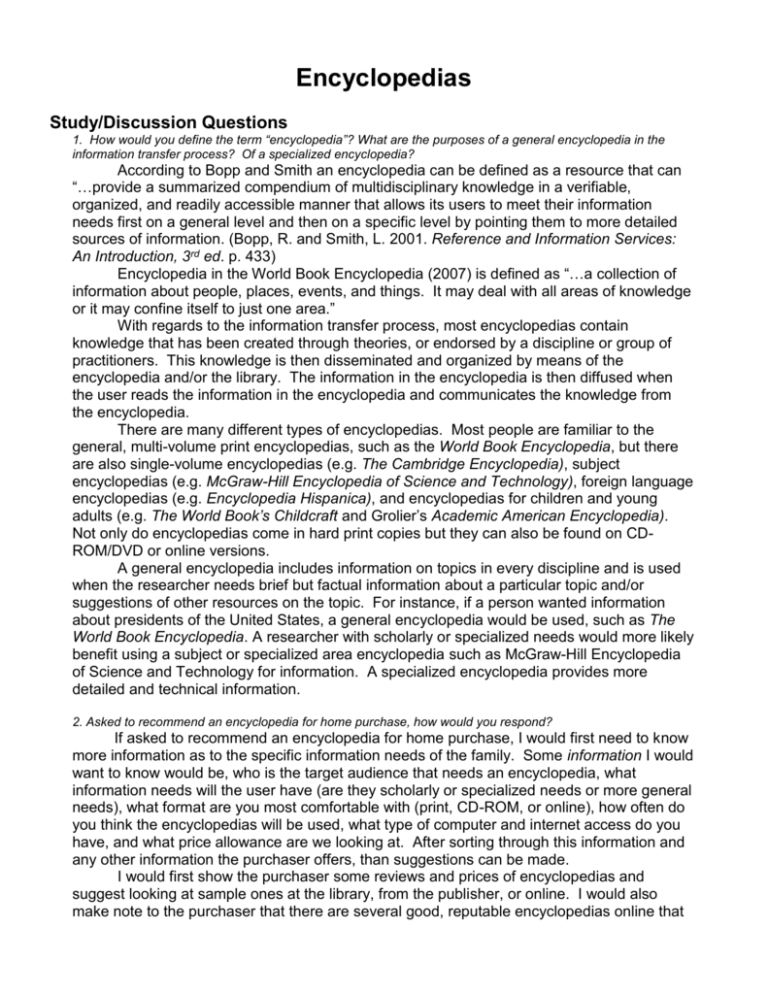
Encyclopedias Study/Discussion Questions 1. How would you define the term “encyclopedia”? What are the purposes of a general encyclopedia in the information transfer process? Of a specialized encyclopedia? According to Bopp and Smith an encyclopedia can be defined as a resource that can “…provide a summarized compendium of multidisciplinary knowledge in a verifiable, organized, and readily accessible manner that allows its users to meet their information needs first on a general level and then on a specific level by pointing them to more detailed sources of information. (Bopp, R. and Smith, L. 2001. Reference and Information Services: An Introduction, 3rd ed. p. 433) Encyclopedia in the World Book Encyclopedia (2007) is defined as “…a collection of information about people, places, events, and things. It may deal with all areas of knowledge or it may confine itself to just one area.” With regards to the information transfer process, most encyclopedias contain knowledge that has been created through theories, or endorsed by a discipline or group of practitioners. This knowledge is then disseminated and organized by means of the encyclopedia and/or the library. The information in the encyclopedia is then diffused when the user reads the information in the encyclopedia and communicates the knowledge from the encyclopedia. There are many different types of encyclopedias. Most people are familiar to the general, multi-volume print encyclopedias, such as the World Book Encyclopedia, but there are also single-volume encyclopedias (e.g. The Cambridge Encyclopedia), subject encyclopedias (e.g. McGraw-Hill Encyclopedia of Science and Technology), foreign language encyclopedias (e.g. Encyclopedia Hispanica), and encyclopedias for children and young adults (e.g. The World Book’s Childcraft and Grolier’s Academic American Encyclopedia). Not only do encyclopedias come in hard print copies but they can also be found on CDROM/DVD or online versions. A general encyclopedia includes information on topics in every discipline and is used when the researcher needs brief but factual information about a particular topic and/or suggestions of other resources on the topic. For instance, if a person wanted information about presidents of the United States, a general encyclopedia would be used, such as The World Book Encyclopedia. A researcher with scholarly or specialized needs would more likely benefit using a subject or specialized area encyclopedia such as McGraw-Hill Encyclopedia of Science and Technology for information. A specialized encyclopedia provides more detailed and technical information. 2. Asked to recommend an encyclopedia for home purchase, how would you respond? If asked to recommend an encyclopedia for home purchase, I would first need to know more information as to the specific information needs of the family. Some information I would want to know would be, who is the target audience that needs an encyclopedia, what information needs will the user have (are they scholarly or specialized needs or more general needs), what format are you most comfortable with (print, CD-ROM, or online), how often do you think the encyclopedias will be used, what type of computer and internet access do you have, and what price allowance are we looking at. After sorting through this information and any other information the purchaser offers, than suggestions can be made. I would first show the purchaser some reviews and prices of encyclopedias and suggest looking at sample ones at the library, from the publisher, or online. I would also make note to the purchaser that there are several good, reputable encyclopedias online that are free of charge. The encyclopedias for purchase online give a few days use free of charge in order to allow the purchaser time to explore. In question number three, suggestions of encyclopedias are made that are appropriate for different ages and uses. 3. Which encyclopedias do you consider most appropriate for adults? High school students? Upper elementary grade children? Primary grade children? Pre-school children? Adult Encyclopedias Most common multi-volume: 1. New Encyclopedia Britannica (full length)-considered most scholarly-some find that it can be difficult to use but the depth and extent of research contained within the encyclopedia outweighs the difficulties of its use. It has CD and online versions (p. 450). 2. Encyclopedia Americana (full length)-prides itself on its focus on US history, geography, and biography, science, and technology (p. 451). It has online and CDROM/DVD editions. 3. Academic American Encyclopedia (mid-length)-focuses more on extent of coverage than on detail (p. 450). It also comes in CD-ROM and online versions. 4. Funk & Wagnalls New Encyclopedia (mid-length) not in print anymore but continues to produce CD/DVD versions, and online versions. It also has a chat room for students and teachers, and aids for writing term papers. It’s easy to search on. (p. 451-2) Other Mentionable Encyclopedias – 1. Microsoft Encarta Encyclopedia Deluxe (CD-ROM) most user friendly of all CDROM encyclopedias. Usually comes with Microsoft computers and is free on the web. It gives links to online sources. 2. Encyclopedia.com (Concise Columbia Electronic Encyclopedia (3rd ed.) Unabridged - allows users free access to over 17,000 articles. Adult Single Volume1. The Columbia Encyclopedia. (p. 452) fully updated entries 50, 000 articles, 1500 new entries available on the web. 2. The Cambridge Encyclopedia. (p. 452) 36, 000 entries Adult Subject Encyclopedia (p. 453) 1. Gale Encyclopedia of Multicultural America 2. Encyclopedia of Multiculturalism 3. McGraw-Hill Encyclopedia of Science and Technology Encyclopedias for Children and Young Adults – many of these encyclopedias are offered online or CD-ROM/DVD All ages World Book Encyclopedia Microsoft Encarta and World Book Millennium Edition (CD-ROM) It promotes use for all ages but it is better suited for an older audience. Preschool and Primary DK First Encyclopedia DK First Animal Encyclopedia DK First Nature Encyclopedia. Elementary School & Middle School World Book’s Childcraft - elementary The Oxford American Children’s Encyclopedia (smaller multi-volume) - ages 8 to 13 (highly recommended in our book) Compton’s Encyclopedia - upper-elementary and middle-school The New Book of Knowledge – elementary and middle-school students The World Book Student Discovery Encyclopedia (multi-volume) – elementary age children Kingfisher Children’s Encyclopedia (single volume)- grades 4 to 8 Scholastic Children's Encyclopedia – ages 9 to 12 Children’s Illustrated Encyclopedia – ages 9 to 12 Scholastic Children’s Encyclopedia – ages 9 to 12 High School Grolier’s Academic American Encyclopedia – YA grades 9 and up Oxford Family Encyclopedia (single volume)– secondary to college #4 What effects have “electronic encyclopedias” had? How does this format influence the organization and use of knowledge? Since 1995, electronic encyclopedias have become more common and more cost effective. Some encyclopedia companies have ceased print publications of their encyclopedias and only offer CD-ROM/DVD and free and fee based online encyclopedias, while others offer both print and electronic formats. Users expect libraries to offer free online and/or CD-ROM/DVD encyclopedias and many universities also offer free access to online encyclopedias. Online encyclopedias are liked because of their interactive use, inclusion of multimedia tools, and links to a wealth of other information. The electronic encyclopedia, especially the online version, can take the user immediately to the information that is needed and also to many other suggested links without having to tote and sort through many different volumes of books. Instead of just a small amount of information offered in the print version, the online version quickly links the user to more information if needed. One thing the online users must be aware of when information links are given is to check the authority of the information. Practical Exercises 1. What is the origin of the term “flying saucer”? When looking for the term “flying saucer”, the World Book Encyclopedia’s (2007) index referred me to “unidentified flying object (UFO)” and “Roswell”. flying saucer – the term was coined by the press in 1947 to describe a sighting speeding objects in the sky by pilot, Kenneth Arnold, who was flying his airplane at the time. Microsoft Encarta Online states that “Sightings of unusual aerial phenomena date back to ancient times, but UFOs (sometimes called flying saucers) became widely discussed only after the first widely publicized U.S. sighting in 1947. Many thousands of such observations have since been reported worldwide. (retrieved March 1, 2008, http://encarta.msn.com) 2. What was the purpose of hieroglyphics in ancient Egypt? I found this information in the World Book Encyclopedia (2007) and in World Book Student Discovery Encyclopedia (2003) in several different places such as hieroglyphics and Alphabet (The Egyptians). Hieroglyphics- are pictorial characters that were literal representations of ideas. The writing was primarily used for religious inscriptions on temple and stone monuments. It was also used to record the words and deeds of royalty. 3. A junior high student wants information on Alaska’s main industries. Where do you start? First look in the index of an encyclopedia under Alaska to see if there are any subheadings for industry, economy, or products; or if using an electronic form, type in Alaska industries. If there are, go to those pages or sites. If not, go to the Alaska pages or site and this should be divided into subheadings. Find the subheading that best fits, such as economy, industry, products, etc. The World Book Encyclopedia (2007) had this information under Alaska; economy. 4. A 7th grader wants to learn more about drug use and AIDS. Print Version- The student should look in the encyclopedia’s index under drug abuse and AIDS to see if there are any headings encompassing both topics. Information on these related topics was found in the World Book Encyclopedia (2007), under “drug abuse-AIDS (How HIV is transmitted).” Online Version- MSN Encarta gave lots of information and links about these topics when I typed in “drug abuse and AIDS”. The print version, in this case would probably be easier to use for a seventh grader because the online information was overwhelming, but it really depends on how much information the student needs. 5. What kind of clothes were worn in ancient Crete? Women and men athletes wore little more than a loincloth. Wall paintings show goddesses and priestesses wearing what was probably the dress of upper-class women, consisting of a short-sleeved, laced bodice cut to expose the breasts; a long, bell-shaped skirt; and a tight sash around the waist. MSN Encarta – retrieved 4-308 6. Where would you find the causes of the Crusades? The World Book has this information along with MSN Encarta online. 7. What would be a good source for a 6th grader who wants to know what an abortion is? MSN Encarta has some information that is simple to read and understand. World Book and Grolier’s would be some examples of encyclopedias for 6th graders. 8. A SLIS student want a brief history of online information services. What a good source? The student could check in the Encyclopedia of Library History or Encyclopedia of Library and information Science. The student could also check with the American Library Association online. ALMANACS, YEARBOOKS AND, HANDBOOKS Study/Discussion Questions 1. Define almanac and give its purpose. An almanac is an annual publication containing practical information that is also factual, such as data and/or statistics on sports, zip codes, first aid treatment, populations, time zones, calendars, astronomical data, and moon phases. 2. What is a yearbook and how is it best used? Yearbooks are published annually and they provide information about events and data for a given year. An example would be an encyclopedia’s yearbook. Yearbooks are usually organized in the chronological order of the year. Yearbooks contain more readable information about events that happened within the designated year than an almanac does. So if a person wants more details about an event than maybe a few statistics, than they should consult the yearbook. 3. What is a handbook? What is its purpose? Handbooks review a particular topic, often with large amounts of factual information put in a single publication. Since a handbook gives extensive information about one topic, if a person can find a handbook on their topic, he/she can usually find the needed information. 4. What is a ready reference question? Give an example. A ready-reference question is a basic, factual question about someone’s life or career. For example: When was President Kennedy born? How many children did he have? 5. What is a directional question? Give an example. A directional question is asked by the patron when he/she wants directions to locate a resource or book, etc. (e.g. Where are the encyclopedias?) Practical Exercises All information retrieved 3/22/08 1. What is the significance of April 19 in Venezuela? This is their Declaration of Independence according to TradePort Country Profiles from World Trade Press www.tradeport.org 2. Where would you find a diagram for a formal dinner place setting? Post, R. (2004). Emily Post’s Etiquette: 17th Ed. A Definitive Guide to Manners. New York, Harper Resource. P. 380. 3. Where is the world’s oldest surviving working clock? Salisbury Cathedral in southern England is the world’s oldest mechanical working clock and it dates from about 1386. www.forbes.com Forbes.com & www.wikipedia.com Wikipedia.com 4. What is the hardest substance in the human body? Enamel is the hardest substance in the human body. BBC Science and Nature http://www.bbc.co.uk/science/humanbody/body/factfiles/teeth/teeth.shtml 5. Who was Odin in Norse mythology? Odin is considered the chief god in Norse mythology. Also known for his love for the battle, and "father of the slain". http://www.ancientmythology.com/norse/odin.php 6. Who won the New York Drama Critic’s Circle Award in 1954-55? Best American Play: Cat on a Hot Tin Roof (Tennessee Williams) Best Foreign Play: Witness for the Prosecution (Agatha Christie) Best Musical: The Saint of Bleecker Street (Gian-Carlo Menotti) http://www.dramacritics.org/dc_pastawards.html#1955 New York Drama Critics’ Circle 7. Who said, “The only way to get rid of temptation is to yield to it”? Oscar Wilde said this quote. He was an Irish dramatize, novelist and poet. He was born 1854 and died in 1900. www.brainyquote.com/quotes/quotes/o/oscarwilde108207.html Brainy Quotes http://www.coolquotescollection.com/Wisdom111.aspx Cool Quotes Collection. http://www.memorable-quotes.com/oscar+wilde,a368.html Memorable- Quotes.com 8. What player was picked first in the NBA draft in 1993 and by what team? Chris Webber was 1st round pick by the Orlando Magic http://www.basketball-reference.com/draft/NBA_1993.html From BasketballReference.com 9. When was the Warsaw Pact dissolved? The Warsaw Pact was officially dissolved at a meeting in Prague on 1 July 1991. http://www.warsaw-life.com/poland/warsaw-pact Warsaw-life.com http://encarta.msn.com/encyclopedia_761569852/warsaw_pact.html Encarta Encyclopedia 10. What is the correct way to address a letter to your representative in Congress? According to: About.com: US Government Info http://usgovinfo.about.com/library/weekly/aa020199.htm and http://www.house.gov/burton/letters.htm The Honorable (full name) (Room #) Name of House Office Building United States House of Representatives Washington, DC 20515 Dear Representative: 11. What percentage of American households owned cats in 1993? According to the 1990 U.S. Census Data Nationwide, approximately 30% of households have cats. In rural areas where free-ranging cats are usually not regarded as pets, approximately 60% of households have cats.( http://wildlife.wisc.edu/extension/catfly3.htm ) & (http://www.thepetcenter.com/imtop/speaker3.html ) 12. What is the average sale price of a home in Schenectady, NY? $210,795 according to http://www.trulia.com/real_estate/Schenectady-New_York/ Trulia Real Estate Search 13. What is the median age of men living in Lexington, KY? The median age of men living in Lexington, KY is 31.7. Copyright 2008 from IDcide http://www.idcide.com/citydata/ky/lexington.htm BIBLIOGRAPHIC SOURCES Study/Discussion Questions 1. What is bibliography? How does bibliography facilitate the organization and use of knowledge? Bibliographies answer a wide variety of questions by acting as a guide to identify resources on various topics. A bibliography organizes resources that contain knowledge. If a user can’t find a resource for an information need, then their question will not be answered. 2. What are different types of bibliographies? National bibliographies – A collection of works published within a specific country. Trade Bibliographies – A collection of works by commercial publishers. They contain information about trade books (book for sale to the general public.) Library Catalogs – They assist users by providing information on materials located in the library. Bibliographies of Bibliographies – They are used when trying to find lists of works about a particular subject. Subject Bibliographies – A collection of works pertaining to a certain topic. 3. What are the elements, or ports, of a systematic enumerative bibliography? Systematic enumerative bibliography refers to a list of works put together on some common principle to organize it, such as authorship, subject, place of publication, chronology, or printer/publisher. The primary arrangement of the list us usually alphabetical 4. What is meant by bibliographic control? How is it accomplished? Bibliographic control is a way of providing two different kinds of access to information. Bibliographic access – lets the user know the item exists. Physical access – lets the user know where the item can be found. It is accomplished by using 3 major types of reference sources – bibliographies (lists the works even if they aren’t in that library), library catalogs (lists the works in that library and maybe a corresponding library), and bibliographic utilities (provides a complete machine-readable cataloging copy and a list of libraries that own the item). 5. What is the purpose of a catalog? A catalog is a recording of items found in a collection and it ensures retrieval of that item by telling is location in the library. In a library the OPAC (online public access catalog) is an electronic catalog designed for the patron. 6. What is a union catalog? What are its uses? The union catalog is a listing of the material held in the collections of more than one library. OCLC and RLIN are bibliographic utilities that serve as union catalogs for their member libraries. When using the union catalog, users will know if the material needed is in the collection and where it is held at. 7. How do we gain bibliographic control of software and nonprint media? Bibliographic control of software and nonprint media is basically the same as print media. Through MARC records, the objects, such as audio, video, maps and other nonprint items, are described and become part of the bibliographic records. For information on the Internet, metadata is still evolving. Librarians and others hope to create scheme for records that would describe the material that exit only in electronic format. Practical Exercises 1. Where would you find the title of the latest Stephen King Novel? Books in Print would be a good source along with Amazon.com and Fantastic Fiction at www.fantasticfiction.co.uk/k The title is Duma Key (Jan. 08) 2. Who wrote “Cut the Mustard: Create Your Own Destiny”? Who is the publisher? Author: Trevor T. Mordecai Publisher: Cheam Pub Ltd (October 1988) From Amazon.com 3. Where would you find listings of educational films about AIDS? OCLC WorldCat.org National AIDS Clearinghouse: Videos www.Hopkins-HIVGuide.org Global Health.org also listed films on AIDS 4. Where would you locate the distributor of the film: “Thumbs Up for Kids: AIDS Education”? OCLS WorldCat.org list Media Express, Inc.; AIMS Media. From Van Muys, CA The web also can be used to look up the film and distributor. 5. Are there any gospel radio stations in Jacksonville, Florida? One the Radio.Net list gospel stations for Jacksonville, Florida 6. What is the phone number of Brewer’s Digest magazine in Chicago? 4049 W. Peterson, Chicago, IL (312)463-3401 anywho.com 7. How much is a subscription to the Journal of Finance? From http://www.blackwellpublishing.com/subs.asp?ref=0022-1082 Journal of Finance 2008 Annual Subscription The Americas Canada/Mexico* (US) Europe** Rest of World Institutional: Print + Premium Online*** $454 $508 £352 £352 Institutional: Print + Standard Online*** $413 $462 £320 £320 Institutional: Premium Online Only*** $392 $392 £217 £217 Commercial companies: Print + Premium Online $505 $590 £408 £408 Commercial companies: Print + Standard Online $459 $536 £372 £372 Commercial companies: Premium Online Only $436 £242 £242 $436 8. Where would you find a list of airline travel magazines? Google Travel Publications at: http://www.travelpublicationsupdate.com/publications.asp 9. Where would you find books on the history of Elizabethan drama? OCLC WorldCat at: http://worldcat.org 10. Look up a favorite book or author in Book Review Digest. In what journals are the review located? Who wrote the reviews? The Butterfly Alphabet By Brian Cassie & Jerry Pallotta Review Journals: Barbara Feldstein – Appraisal Nancy Bluntzer – Appraisal v. 29, p. 13 W/Sp ‘96 v. 29, p. 13 W/Sp ‘96 Amy Alder - SLJ v. 41, p. 95 D’95 Paul Shubeck – Schience Book & Films v. 32, p. 17 J/F ‘96 11. Look up the same author in Book Review Index. What other reviews are listed here? ASBYP (Science Books for Young People) v. 29 – Win. ’96 p. 13 + [251-500] HB Guide (Horn Book Magazine) v. 7 – Sp ’96 p. 113 [51-250] SB (Science Books & Films) v. 32 J’96 p. 17 [ 51-250] SLJ (School Library Journal ) v. 41 D’95 p. 95 [51-250] BIOGRAPHICAL SOURCES Study/Discussion Questions 1. What are the special evaluation criteria for biographical information sources? How can authority be determined? Scope (who is in the work), comprehension (criteria for who is included), accuracy (is it accurate), currency (is information current or has it changed), references (are they reliable), format (is the work well organized), cost ( is it cost effective), uniqueness (what is unique about it). Authority is very important to know but hard to determine. There are really only 2 ways, from the biographies themselves and from writings about those individuals. Librarians faced with conflicted information should check other sources to determine the truth. The publisher is another indicator of authority. If the information is not from a reputable publisher, than authority should be questioned. 2. Which are the leading publishers of biographic information sources? H.W. Wilson, Reed Elsevier (and its subsidiaries, Marguis Who’s Who and R.R. Bowke) and the Gale Group (and its subsidiary, St. James Press). 3. What are some facts that are helpful in biographical searches? Name of individual the biography is about. Is the person alive? What nationality is he or she? Is he or she an author, politician, scholar, etc? Practical Exercises 1. Where would you look for information on Matt Dollar, Elvis impersonator? http://mattdollar.tripod.com/ Matt “Elvis” Dollar – orAmazon.com has a book “I Am Elvis: A Guide to Elvis Impersonators” that Matt Dollar is featured in. 2. A student wants to do a paper on entrepreneurs. Where would you get some names of entrepreneurs for her to research? This site was listed as a best resource at http://library.sau.edu Biography.com http://www.biography.com/search/biography.do?keywords=entrepreneurs&imageField2.x=16 &imageField2.y=10 3. Where would by find a biography of Clarence Thomas? The Columbia Electronic Encyclopedia, 6th ed. Copyright © 2007, Columbia University Press. Biography.com -or- Justices of the Supreme Court at http://www.supremecourtus.gov/about/biographiescurrent.pdf OR Federal Judicial Center at; http://www.fjc.gov/public/home.nsf/hisj 4. Where would you find how Alexandra Ripley came to write Scarlett, the sequel to Gone With the Wind? Biography data on Alexandra Ripley at Barnes & Noble online and Amazon.com The report said that she was chosen to write Scarlett by the Margaret Mitchell estate. 5. Who was Abner Doubleday? He invented the modern game of baseball. http://www.arlingtoncemetery.net/doubledy.htm http://www.historybuff.com/library/refearlybase.html 6. Where was Harry Belafonte born? New York City http://www.unicef.org/people/people_harry_belafonte.html http://www.infoplease.com/biography/var/harrybelafonte.html 7. Who is Bulat Shalvovich Okudzhava? Russian poet whose works helped create important literature of dissent in Soviet Union in 1950s and '60s. http://www.infoplease.com/ipa/A0197742.html 8. Who was Jean Paul Sartre? French philosopher, playwright, and novelist http://www.infoplease.com/ce6/people/A0843717.html 9. What is the address of Ross Perot’s Dallas office? Perot Development Co., 5430 Lyndon B. Johnson Fwy, Suite 1200 Dallas, TX 75240 (anywho.com) 10. A faculty member wants to contact Robert Novick, a physicist. How would you get his home or work address? He Died May 6, 2007. He is buried at Mount Auburn Cemetery in Cambridge, Massachusetts. Dictionaries Study/Discussion Questions 1. Define dictionary. A dictionary is a reference book that contains words with their definitions and the words are in alphabetical order. It also usually gives information about grammar, pronunciation and origin of the word (etymology), synonyms and antonyms, usage, etc. 2. Define the difference between “prescriptive” and “descriptive” schools of thought regarding language usage and the role of dictionaries. Give examples of both prescriptive and descriptive dictionaries. Descriptive Dictionary – is how the language is actually used. (e.g. www.urbandictionary.com the Urban Dictionary: Define Your World) Prescriptive Dictionary - how language should be used. Our book says that most dictionaries not the strict prescriptive approach anymore. Some dictionaries such as desk and specialized usage dictionaries still maintain the more conservative approach. (e.g. Dictionary of Science) 3. Who are the most reputable publishers of dictionaries? Gage Educational Publishing, Harcourt Brace, Harper-Collins, Houghton Mifflin, Macmillan USA, Merriam-Webster, Oxford university Press, Random House, World Book 4. What is the principal use of OED? Oxford English Dictionary- is an etymological dictionary (word origin). The OED is considered the best source for etymology, and it gives definitions and quotations in great detail of each word. 5. How do “desk” or “college” dictionaries differ from unabridged or comprehensive dictionaries? Desk or College dictionaries contain a selective compilation of words for college level and adult use. Unabridged or comprehensive dictionaries are much larger dictionaries in that they contain all words in the language that are in use at the time. They are not condensed. 6. To what extent is the name “Webster” in a dictionary title an indicator of quality or authority? The name “Webster” has no copyright on the use and anyone can claim to have a “Webster Unabridged”. This could mean just cheap desk dictionary. 7. Which dictionaries would you recommend for home use? Why? It depends on the users in the home and it depends if there is quick access to the internet for online versions. For instance, if it is a Spanish speaking family, they would benefit with a dual-language dictionary from a leading published like HarperCollins. If it is a family with high school and college students, I would recommend an abridged edition if there is also access to the internet. The dictionary should be from a leading publisher such as the Merriam-Webster Collegiate Dictionary. Elementary and high school students would have better success with The American Heritage Dictionary of the English Language. Either way, I would always recommend having a print edition incase the computer is inaccessible. 8. Which dictionaries would you recommend for questions related to American usage? These 3 dictionaries are the only good unabridged English-language dictionaries according to our book. Webster’s Third New International Dictionary of the English Language, Unabridged The Random house Webster’s Unabridged Dictionary, 2d ed. Funk & Wagnalls New Standard Dictionary of the English Language 9. What is the purpose of a slang dictionary? A slang dictionary will define colloquial and vulgar terms in more depth. Many times a standard dictionary will not have these terms. 10. What is the difference between a thesaurus and a synonyms dictionary? What are the advantages and disadvantages of each? What are the uses of each? A thesaurus is a specialized dictionary that works only with synonyms and antonyms. A synonyms dictionary would just have synonyms. A thesaurus or synonym dictionary, are mainly used by writers and crossword puzzle enthusiasts. A disadvantage of these dictionaries is that the user must have a good vocabulary because the synonyms can have totally different meanings then the original word. It depends on the context of that word. Directories 1. What is a directory and what is its purpose? Definition: “a list of persons or organizations, systematically arranged, usually in alphabetic or classes order, giving address, affiliations, etc. for individuals, and address, officers, functions, and similar data for organizations. (the ALA Glossary of Library and Information Sciences in Bopp and Smith, p. 331) Purpose: Directories are used to assist users in finding information about people, organizations and institutions that will assist them with their information need outside of the library. 2. What is an example of a directory that you probably use on a daily basis? A telephone book. 3. On what criteria would you base your selection of directories to be included in your library collections? The types of directories included in the library collection should be ones that would benefit the community. Some things to consider before selecting directories would depend on the community being served, kinds of questions that are asked at the reference desk, and on the number of questions in a particular subject area. The library might also want to consider if the directory is free online. Practical Exercises – (answer the question and include the title of the source consulted). If you use an Internet based source, also answer the question with the source you would use if your Internet connection was down for the day. 1. What is the zip code of Ephrata, Pennsylvania?17522 (Zip Code and Post Office Directory 2. What companies manufacture refrigerated display cases? Found in Standard and Poor’s Register of Corporations a listing of Corporations that deal with refrigeration equipment and Supplies Merchant Wholesalers. The telephone directory tells also of refrigeration equipment. Many names are also listed on Google under refrigerated display cases such as “Central Restaurant Products” 3. What is the address of the Gay Veterans Association? (Encyclopedia of Associations) (Gay) American Veteran’s for Equal Rights formerly Gay Veteran’s Association PO Box 97 Plainville, IL 62365-0097 Gay, Lesbian, Bisexual, and Transgenered Disabled Veteran of America c/o Sgt. Sharon F. Daugherty, IL 3124 Scranton St. Aurora, CO 80011 4. What is the name of the special science library in Kansas City? Linda Hall Library of Science, Engineering and Technology (Kansas City Directory) 5. I need the following information about Sysco Corporation:(Found in Standard & Poor’s Register of Corporations, Directors and Executives) DUNS Number (9 digit number)Ticker Symbol (SYY), SIC Code/NAICS (424410) and number of subsidiaries (7). 6. I am going to do some research on entrepreneurship. I would like to determine if there are any organizations that make grants in this area. If so what are their names and contact information? Kansas State University lists grant possibilities http://www.k-state.edu/kscc/resources/funding_opportunities/index.html Kansas Campus Compact Kansas State University 2323 Anderson Ave., Ste. 125 Manhattan, KS 66502-2912 Phone: (785) 532-6896 Fax: (785) 532-0671 Email: kscc@ksu.edu http://www.ksu.edu/kscc ALSO http://www.business.ku.edu/kusbdc/grants.htm Kansas Small Business Development Center would be a place to contact. They can be reached at 785-843-8844 or via e-mail: willkatz@ku.edu 7. Does Microsoft have any non U.S. holdings? Yes from Standard and Poor’s Register of Corporations. Geographic Information Sources 1. Define gazetteer and atlas. Gazetteer: A gazetteer is attached to the atlas or published separately and it is a list of geographic names and/or physical features. There are two types of gazetteer – locational and descriptive. Atlas: a collection of maps and vital statistics relating to geographic regions. There are three groups: current (up-to-date information on the world), historical (for boundary changes, military campaigns, early exploration, etc.), and thematic (a specific region or subject). 2. List and explain the unique criteria which are applied to geographical information sources. (taken from Bopp and Smith, p. 462-6) Scale - The most important element on a map. It is the ratio of the distance on the map to the actual distance on the face of the Earth Projection- When a spherical globe is drawn or projected on a flat piece of paper. Distortion and errors can occur when this is done. Color – Used in different ways and for different purposes. Variants of color can be used to show land heights, ocean depths, etc. Symbols- Each resource should provide a key or index to its symbols in order to communicate its information to the reader. Symbols can be used for such things as roads, railroads, rivers, etc. Publisher/Authority- Is the resource made by a reputable person or agency. Indexing/Place Names – needs to be user friendly because it is what allows the user to be able to use the map. Currency – Since the world changes so rapidly, geographical sources need to be up-to-date. Practical Exercises (all information retrieved on Tuesday, April 08, 2008) 1. Are there any volcanoes in Africa? Yes, (MSN Encarta) 2. Where is the island of Saipan? Saipan is an island in the western Pacific Ocean. It is the second largest of the Mariana Islands. (MSN Encarta Atlas and Encyclopedia) 3. How big is Vatican City? .17 square miles (MSN Encarta) 4. What is the most direct route by car from London to Ipswich? First go to Brentwood to Chelmsford to Kelvendon to Colchester to Capel St. Mary, Ipswich According to the MSN Encarta: Virtual Live Search Map (retrieved 4-8-08) http://maps.live.com/#JnJ0cD1wb3Muc2toeWQ3Z3pwZng0X0xvbmRvbiUyYytFbmdsYW5k JTJjK1VuaXRlZCtLaW5nZG9tX19fXyU3ZXBvcy5zcDhwMnloMnZzaDZfSXBzd2ljaCUyYytFb mdsYW5kJTJjK1VuaXRlZCtLaW5nZG9tX19fXyZydG9wPTAlN2Uw 5. Where would you find a map of Athens?MSN Encarta: Virtual Live Search Maps at http://maps.live.com/#JnE9eXAuQXRoZW5zJTJjK0dyZWVjZSU3ZXNzdC4wJTdlcGcuMSZiYj 01Ny45MzgxODMwMTIyMDUzJTdlLTU3LjA0MTAxNTYyNSU3ZTE1LjExNDU1Mjg3MTk0NDEl N2UtMTMzLjY4MTY0MDYyNQ== (retrieved 4-8-08) 6. Where would you locate a map of Boston as the city appeared in 1722? Historical maps at MIT Library http://ocw.mit.edu/ans7870/11/11.001j/f01/lectureimages/2/image3.html 7. Are there any gold deposits in Australia? Yes, in greenstone in the Golden Mile in Kalgoorlie, Western Australia, is an example http://volcano.und.nodak.edu/vwdocs/minerals/gold.html 8. Where in the world is the greatest concentration of people speaking Indo-Aryan languages? Eastern Europe as per Encyclopedia Britannica Online 9. How do you pronounce Nukualofa and where is it located? Nukualofa, capital and largest town of Tonga, on the northern coast of Tongatapu Island, in the southern Pacific Ocean. (MSN Encarta) Merriam-Webster online: http://www.merriam-webster.com/dictionary/Nuku Pronunciation: \ˌnü-kü-ä-ˈlō-fä\ 10. Where would you find a map of major hazardous waste sites in the United States? Nationalatlas.gov at http://nationalatlas.gov/ 11. Where would you find a map showing the annual precipitation of Europe? MSN Encarta Premium World Atlas (monthly fee of $4.95 for this service) 12. Where can I find a list of the hotels near Niagara Falls? Niagara Falls Tourism Authority at: www.niagarafallshotels.com Government Documents and Statistical Sources 1. What is meant by “government document”? Government documents are formal pieces of writing that provides information and are published by the government. 2. Discuss briefly ways in which government information is created, recorded, published, disseminated and organized. As government agencies are doing their work, they often produce statistical and economic data that is recorded, such as population census. This information is then published by the U.S. Government Printing Office (GPO). Databases such as, GPO Access, help the reference desk conduct reference information searches. Government documents are organized using the SuDoc (Superintendent of Documents) classification system. 3. What are the major problems associated with the purchase, organization, and use of government information sources? Problems: If your library is not a government document depository, (in which gets the documents free of charge), then additional costs can be associated with the item ordered. Nongovernmental document depositories also have to order what they need or want since there are an abundance of documents produced yearly. This means that the librarian needs to be attuned to the needs and interests of the library users along with knowing current events. Once the documents are received than the library has to decide which classification system to use and how many items the library collects. Other problems that can hinder use of government documents are not having the document needed. If the document is online, not knowing how to use the internet or no access. Online access sometimes is not available. 4. What is meant by “privatization”of government information? What is the impact on information users? On libraries and other information agencies? Privatization means that a publisher can repackage and sell government data. When the publisher repackages data, it makes the data more usable through better indexing, and with electronic mediums it creates a better interface with improved searching. Libraries and other information agencies, who are not depositories, have to purchase the government data packages, that include these features from the publisher. 5. Look up a subject in government documents and record your reaction. I went to www.gpoaccess.gov and was happy to see that it was user friendly. I went to science.gov and then to “health and medicine”. From there I can narrow the list or look up data alphabetically. I was amazed at all the information available. Some sites were like games for kids and some sites gave names and prices of the publication. I went into Mind and Body and found a great place for elementary students to access. I then went back to the main screen and looked up education and found many publications, some were available for viewing and others had to be purchased. It basically gave the ED and EC numbers, author , title, institution, sponsoring agency, ISBN, abstract, etc. INDEXES AND ABSTRACTS Study/Discussion Questions 1. What is an index? What is the purpose of an index? How do indexes facilitate the organization and use of knowledge? An index is a resource that lists published work alphabetically, by either subject, title or author. It gives more information that is not in the libraries catalog. For instance, it can list each poem in a poetry collection. The purpose of an index is to make information more accessible to the user. Since indexes organize the information, and make it more accessible for the user, the user can find the information easier and therefore use the knowledge. 2. Name 5 different types of indexes and give an example of each. General Periodical Index: The Readers’ Guide to Periodical Literature or Reader’s Guide Newspaper Index: New York Times Index Broad Subject Periodical Index: Public Affairs Information Service (PAIS) International in Print. Citation Index: Science Citation Index Indexes of Reviews: Book Review Index 3. What is an abstract? Abstracts present a brief summary of the items content. Most abstracts are descriptive but some contain evaluating critics by the abstractor. 4. What are the major differences between indexing and abstracting? Abstracts give descriptions of the work, and indexes just list the works. 5. When evaluating indexes the unique features to consider are: If the work includes a list of periodicals or other sources indexed and a published list of subject headings. Also the coverage and arrangement, such as cross-referencing, access points. 6. What is a concordance and how does it differ from an index? A concordance is an index of words that gives information about the meaning and context of a listed word that is in the index. It is a special type of index. 7. What are the differences among indexes, bibliographies, and catalogs? An index lists the specific information from within the resources. A bibliography lists books and article on a subject or by a specific author. A catalog lists the holdings in a library. 8. How has technology changed the nature of indexing and abstracting? Many more indexes and abstracts can be found that are more in depth. Practical Exercises 1. Where would you find information on the escalating costs of health insurance in America? A.: There are many scholarly articles in periodicals abstracted at ScienceDirect.com such as: Preventative Medicine, Aug. 2002; New England Journal of Medicine, 1999; Social Science and Medicine, April 2001. What were the major elements of Bill Clinton’s health care plan? Government takeover of health care system (socializing America’s Health System), each citizen had to be enrolled in a plan and could not unenroll until another plan with taken, fees for services depended on income. 2. What are the latest developments in electronic mail systems for businesses?According to Briticanna Online (2006) Krol, Carol. B to B, 2006 Interactive Mar, Vol. 91 Issue 5, p10-18: “expecting electronic mail effectiveness to increase in the next three years. Tools and technology designed to comply with CAN-SPAM and improve deliverability, such as authentication of electronic mail messages, have also begun to have an effect, making marketers even more comfortable with using electronic mail again.” (retrieved 4-24-08) By: Krol, Carol. B to B, 3/12/2007, Vol. 92 Issue 3, p1-41: “Cisco Systems Inc. announced that it has agreed to acquire IronPort Systems Inc., an anti-spam and spyware protection services company.” 3. Where would you find guidelines on Kosher food? http://www.jewfaq.org/kashrut.htm Judiasm 101 4. Where would you find guidelines on how to shop for a new car? http://www.ehow.com/how_366_shop-new-car.html EHow.com http://www.carbuyingtips.com/ Car Buying Tips.com http://www.autotrader.com/ Autotrader 5. Where would you find information on automation systems for libraries? http://www.fsc.follett.com/page/library_manager/?gclid=CIa6uv3m9JICFRk8Igod0z_A Bw Follett Software .com http://www.librarytechnology.org/ Library Technology.org 6. Where would you find information on Greco-Roman mosaics? http://www.houseofptolemy.org/house002.htm The House of Ptolemy Annex http://www.theoi.com/greek-mythology/sea-gods.html Theoi Greek Mythology 7. Where would you look to research the Bronze Age in Palestine? Encyclopedia Britannica Online, Encarta Online 8. Where would you look to find accounts of the floods in Des Moines last summer? http://www.iowahomelandsecurity.org/Disasters/DisastersinIowa/tabid/71/Default.aspx Iowa Homeland Security http://www.desmoinesregister.com/apps/pbcs.dll/article?AID=/20080310/NEWS02/80310 0323 Des Moines Register. com 9. What economic proposals did President Clinton make in his 1993 State of the Union Address? http://www.cspan.org/executive/transcript.asp?cat=current_event&code=bush_admin&year=1993 (retrieved 4-24-08) “The plan I offer you has four fundamental components. First, it shifts our emphasis in public and private spending from consumption to investment, initially by jump-starting the economy in the short term and investing in our people, their jobs, and their incomes over the long run. Second, it changes the rhetoric of the past into the actions of the present by honoring work and families in every part of our public decisionmaking. Third, it substantially reduces the Federal deficit honestly and credibly by using in the beginning the most conservative estimates of Government revenues, not, as the executive branch has done so often in the past, using the most optimistic ones. And finally, it seeks to earn the trust of the American people by paying for these plans first with cuts in Government waste and efficiency; second, with cuts, not gimmicks, in Government spending; and by fairness, for a change, in the way additional burdens are borne.” “To create jobs and guarantee a strong recovery, I call on Congress to enact an immediate package of jobs investments of over $30 billion to put people to work now, to create a half a million jobs: jobs to rebuild our highways and airports, to renovate housing, to bring new life to rural communities.” 10. Where would you find short stories about earthquakes? http://www.storiesville.com/index.php?option=com_search&Itemid=5&searchword=earthquak es&submit=Search&searchphrase=any&ordering=newest Storiesville.com http://www.bibliomania.com/0/5/frameset.html Bibliomania: Free Online 11. Where would you look to find a story about Harry Houdini? Amazon.com 12. How would you find Robert Frost’s poem “The Road Not Taken” in a poetry anthology? I would look in a poetry index under author or title. Amazon.com also offers poetry anthologies for Robert Frost. 13. Where would you find a poem about sheep? A poetry index such as Print: Brewton’s Index to Children’s Poetry: Second Supplement. (1965). New York: H.W. Wilson Co. Compiled by John and Sara Brewton Online: http://www.library.uiuc.edu/edx/poetry.htm This site says that it continues the series of Brewtons' Index to Poetry for Children and Young. It is a free site that is easy to access and use
